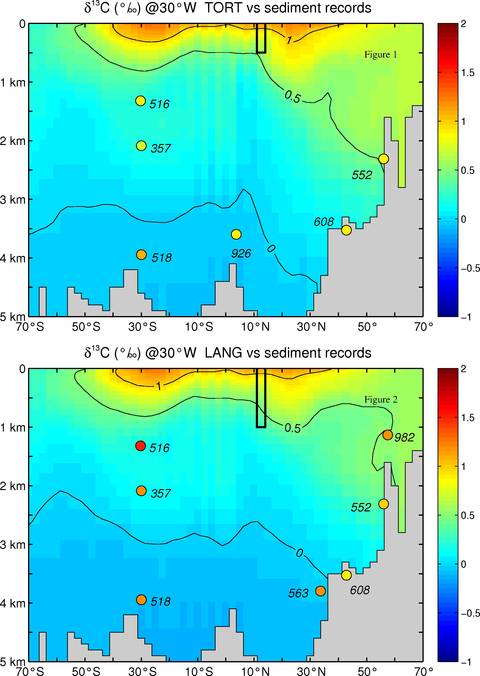Major results
- Different to uncoupled Miocene ocean simulations (i.e. Butzin et al., 2011) the meridional overturning circulation remains rather unaffected when the Panama Seaway is open.
- There are only small changes of simulated deep-sea δ13C distributions between the various model scenarios.
- Simulations and observations of deep-sea δ13C largely agree for the late Miocene (Figure 1) but disagree for the middle Miocene (Figure 2).
- The disagreement points to carbon cycle changes during the middle Miocene.

Meridional distribution of δ13C in the Atlantic along 30°W simulated for the late Miocene (Tortonian, Figure 1) and for the middle Miocene (Langhium, Figure 2). Dots mark observations in sediment records (numbers are codes of drilling sites; compiled from Anderson and Jansen [2002], Shackleton and Hall [1997], and Woodruff and Savin [1989]).
References
Andersson, C., and E. Jansen (2003), A Miocene (8–12 Ma) intermediate water benthic stable isotope record from the northeastern Atlantic, ODP Site 982, Paleoceanography, 18(1), 1013, doi:10.1029/2001PA000657.
Butzin, M., G. Lohmann, and T. Bickert (2011): Miocene ocean circulation inferred from marine carbon cycle modeling combined with benthic isotope records. Paleoceanography, 26, PA1203, doi:10.1029/2009PA001901.
Shackleton, N. J., and M. A. Hall (1997), The late Miocene stable isotope record, Site 926, Proc. Ocean Drill. Program Sci. Results, 154, 367–374.
Woodruff, F., and S. M. Savin (1989), Miocene deep water oceanography, Paleoceanography, 4, 87–140, doi:10.1029/PA004i001p00087.


